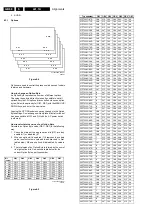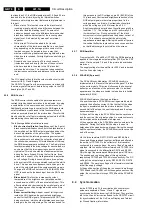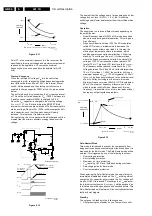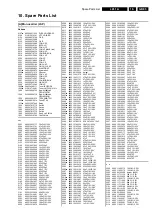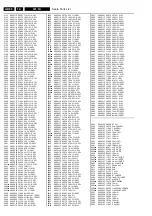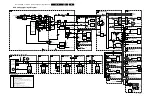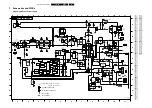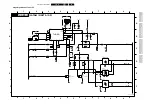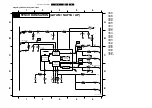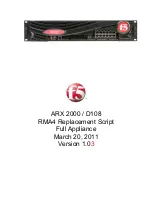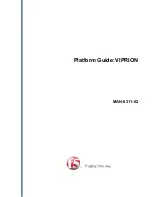
Circuit Description
GB 82
L01.1A
9.
Over Power Protection
During the primary stroke, the rectified AC input voltage is
measured by sensing the current drawn from pin 4 (DEM).
This current is dependent on the voltage on pin 9 of
transformer 5520 and the value of R3522. The current
information is used to adjust the peak drain current, which is
measured via pin I
SENSE
.
Short Winding Protection
If the ‘sense’ voltage on pin 5 exceeds the short winding
protection voltage (0.75 V), the converter will stop switching.
Once V
CC
drops below the UVLO level, capacitor C2521 will
be recharged and the supply will start again. This cycle will
be repeated until the short circuit is removed (safe restart
mode). The short winding protection will also protect in case
of a secondary diode short circuit.
This protection circuit is activated after the leading edge
blanking time (LEB).
LEB time
The LEB (Leading Edge Blanking) time is an internally fixed
delay, preventing false triggering of the comparator due to
current spikes. This delay determines the minimum ‘on’ time
of the controller.
Over Temperature protection
When the junction temperature exceeds the thermal
shutdown temperature (typ. 140º C), the IC will disable the
driver. When the V
CC
voltage drops to UVLO, the V
CC
capacitor will be recharged to the V
(start)
level. If the
temperature is still too high, the V
CC
voltage will drop again to
the UVLO level (Safe-Restart mode). This mode will persist
until the junction temperature drops 8 degrees typically below
the shutdown temperature.
Mains dependent operation enabling level
To prevent the supply from starting at a low input voltage,
which could cause audible noise, a mains detection is
implemented (Mlevel). This detection is provided via pin 8,
that detects the minimum start-up voltage between 60 and
100 V. As previous mentioned, the controller is enabled
between 60 and 100 V.
An additional advantage of this function is the protection
against a disconnected buffer capacitor (C
IN
). In this case,
the supply will not be able to start-up because the V
CC
capacitor will not be charged to the start-up voltage.
9.7
Control
Figure 9-17
9.7.1
Introduction
The microprocessor part of the UOC, has the complete
control and teletext on board. User menu, Service Default
Mode, Service Alignment Mode and Customer Service Mode
are generated by the
m
P. Communication to other ICs is done
via the I
2
C-bus.
9.7.2
I
2
C-Bus
The main control system, which consists of the
microprocessor part of the UOC (7200), is linked to the
external devices (tuner, NVM, MSP, etc) by means of the I
2
C-
bus. An internal I
2
C-bus is used to control other signal
processing functions, like video processing, sound IF, vision
IF, synchronisation, etc.
9.7.3
User Interface
There are two control signals, called ‘KEYBOARD_protn’ and
‘IR’. Users can interact either through the Remote Control
transmitter, or by activation of the appropriate keyboard
buttons.
The L01 uses a remote control with RC5 protocol. The
incoming signal is connected to pin 67 of the UOC.
The 'Top Control' keyboard, connected to UOC pin 80, can
also control the set. Button recognition is done via a voltage
divider.
The ‘KEYBOARD_protn’ line, also serves to detect faults in
the E/W circuit, which would require the
m
P to shut down the
set (by forcing the power supply in standby mode).
The front LED (6691) is connected to an output control line of
the microprocessor (pin 5). It is activated to provide the user
information about whether or not the set is working correctly
(e.g., responding to the remote control or fault condition)
9.7.4
Sound Interface
There are three control signals, called ‘Volume_Mute’,
‘Treble_Buzzer_Hosp_app’ and ‘Bass_panorama’.
The ‘Volume_Mute’ line controls the sound level output of the
audio amplifier or to mute it in case of no video identification
or from user command. This line also controls the volume
level during set switch ‘on’ and ‘off’ (to prevent audio plop).
The ‘Treble’ and ‘Bass’ lines are used (in mono 4:3 sets) to
switch between different smart sound modes. For other set
executions (e.g. stereo, widescreen), they have another
functionality:
–
The ‘Bass_panorama’ line is used to switch the
panorama mode in widescreen sets (to fit 4:3 pictures
into a 16:9 display, it is possible to apply a panoramic
horizontal distortion, to make a screen-fitting picture
without black sidebars or lost video).
–
The ‘Treble_Buzzer_Hosp_app’ is used in ITV
applications for other feautures, and in widescreen sets
to enable the ‘Tilt’ feature (via R3172 on diagram A8) in
the deflection part.
9.7.5
In- and Output Selection
For the control of the input and output selections, there are
three lines:
•
STATUS1
This signal provides information to the
microprocessor on whether a video signal is available on
the SCART1 AV input and output port (only for Europe).
This signal is not connected in NAFTA sets.
•
STATUS2
This signal provides information to the
microprocessor on whether a video signal is available on
the SCART2 AV input and output port (only for Europe).
For sets with an SVHS input it provides the additional
information if a Y/C or CVBS source is present. The
CL 16532016_015.eps
220301
Signal
Processing
User
Interface
uP - Control
LED
PANORAMA
PANORAMA
BUZZ
BASS
TREBLE/Tilt
ITV-DATA-OUT
ITV-DATA-IN
ITV-CLOCK
RESET
VOLUME/
MUTE
IR
KEYBOARD/
(EW protection
STATUS 1
STATUS 2
SEL-MAIN-FRNT-RR
internal I2C Bus
Deflection
16:9
Expansion
Slot
I/O
POWER_DOWN
STBY_CON
Power
Supply
WRITE Enable
NVM
SEL-IF-LL/M-TRAP
I2C Bus
Tuner / IF
Tilt
ITV
or
Pip
Amplifier
Processing
Sound
Summary of Contents for L01.1A
Page 48: ...Spare Parts List GB 88 L01 1A 10 ...
Page 78: ...56 L01 1A 7 Schematics and PWB s Layout PIP Panel Top View CL 16532010_010 eps 210301 ...
Page 79: ...Schematics and PWB s 57 L01 1A 7 Layout PIP Panel Bottom View CL 16532010_011 eps 210301 ...
Page 88: ...66 L01 1A 7 Schematics and PWB s Personal Notes Personal Notes ...

